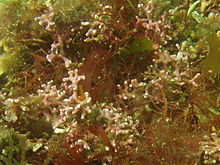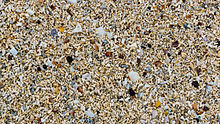


Maerl (also rhodolith) is a collective name for non-geniculate coralline red algae with a certain growth habit.[1] Maerl grows at a rate of c. 1 mm per year.[2] It accumulates as unattached particles and forms extensive beds in suitable sublittoral sites.[3] The term maerl originally refers to the branched growth form of Lemoine (1910)[4] and rhodolith is a sedimentological or genetic term for both the nodular and branched growth forms (Basso et al., 2015).[5]
Description[edit]
In Europe maerl beds occur throughout the Mediterranean, along most of the Atlantic coast from Portugal to Norway, and in the English Channel, Irish Sea and North Sea.[6] The distribution of maerl is dependent on water movement, light and salinity concentration.[7] Maerl beds occur in the photic zone, and can be found to around 30 m depth in the British Isles and up to 120 m deep in the Mediterranean.[8] Maerl deposits can reach up to 10 m thick, but are usually much thinner; carbon dating has shown that they can be more than 5500 years old.[9]
In the British Isles maerl is composed of three species of coralline algae growing loose in beds of fragmented nodules in the sub-littoral. The species generally involved are: Lithothamnion corallioides,[10] Lithothamnion glaciale and Phymatolithon calcareum.[11][12]
Maerl is dredged from the sea floor and crushed to form a powder. It is still harvested around the coasts of Brittany in France and Bantry Bay, Ireland, and is a popular fertilizer for organic gardening. It was also dredged off Falmouth, Cornwall, but this ceased in 2004.
Scientists investigated Falmouth maerl and found that L. corallioides predominated down to 6 m and P. calcareum from 6–10 m.[13][14] A 2024 survey by researchers from the University of Exeter, commissioned by Cornwall Council's Blue Natural Capital Project, found that the Fal and Helford Estuary Special Area of Conservation supports an 880 hectare bed of maerl.[15][16][17]

Chemical analysis of maerl showed that it contained 32.1% CaCO3 and 3.1% MgCO3 (dry weight).
Ecology[edit]
The ecology of maerl habitats has received very little attention in contrast to other marine ecosystems such as kelp forests or sea grass beds.[18] Maerl beds provide a complex habitat for a wide range of taxa[19] with a variety of niches that support high associated invertebrate and algal biodiversity.[7] Maerl beds act as nursery areas for the juvenile stages of commercial species such as juvenile cod Gadus morhua, saithe Pollachius virens, Pollack Pollachius pollachius[20] and juvenile scallops Aequipecten opercularis.[21] Maerl beds offer physical refuge and protection from predation as well as productive feeding grounds but are easily damaged by dredging and towed fishing gear.[8][21]
Maerl has no tolerance for desiccation.[22]
History[edit]
Maerl has been extracted for centuries mainly for use as an agricultural fertilizer. The amount extracted increased in the late 20th century and in 2000, maerl was extracted at c. 5,000 tonnes per year in Ireland and c. 500,000 tonnes per year in France.[18] Large scale maerl extraction over the past 40 years has removed and degraded maerl beds.[23] In Cornwall, England, maerl has been extracted since the 1970s, but was banned in 2005 by Falmouth Harbour Commissioners.[24]
An early reference to maerl was made by John Ray in 1690 who reported it from Falmouth. In Ireland, maerl is extracted from subfossil beds in Bantry Bay by Celtic Sea Minerals.[25] The maerl-forming species Lithothamion corallioides and Phymatolithon calcareum are listed in Annex V of the EC Habitats Directive.[26]
Uses[edit]
Used as a soil conditioner, it is dredged from the sea floor and crushed to a powder.[27] The slow growth of individual nodules and their accumulation in beds over a millennial timescale means that there is no possibility of maerl keeping up with dredging for this purpose. Maerl should be considered as a non-renewable resource, and readily available alternative products (e.g., garden lime) make modern day exploitation controversial.[28][29][30]
References[edit]
- ^ Steneck, R. S. (1986). "The Ecology of Coralline Algal Crusts: Convergent Patterns and Adaptative Strategies". Annual Review of Ecology and Systematics. 17: 273–303. doi:10.1146/annurev.es.17.110186.001421. JSTOR 2096997.
- ^ Blake, C.; Maggs, C.A. (2003). "Comparative growth rates and internal banding periodicity of maerl species (Corallinales, Rhodophyta) from northern Europe". Phycologia. 42 (6): 606–612. Bibcode:2003Phyco..42..606B. doi:10.2216/i0031-8884-42-6-606.1. S2CID 83523566.
- ^ Vize, S.; Blake, C.; Hinojosa, G. and Maggs, C.A. 2003. The distribution and composition of maerl beds in Northern Ireland. PMNHS Newsletter No.13 p.26
- ^ Lemoine (1910). "Répartition et mode de vie du maërl ( Lithothamnium calcareum) aux environs de Concarneau (Finistère)". Annales de l'Institut Océanographique. 1: 1–29.
- ^ Basso (2015). "Monitoring deep Mediterranean rhodolith beds" (PDF). Aquatic Conservation: Marine and Freshwater Ecosystems. 26 (3): 549–561. doi:10.1002/aqc.2586.
- ^ Grall, J., Le Loc'h, F., Guyonnet, B., and Riera, P. (2006) "Community structure and food web based on stable isotopes (δ15N and δ13C) analysis of a North Eastern Atlantic maerl bed". Journal of Experimental Marine Biology and Ecology 338, 1–15 [Online] Available at: http://horizon.documentation.ird.fr/exl-doc/vcc/2006/11/010037649.pdf[permanent dead link]
- ^ a b Wilson, S., Blake, C., Berges, J.A., and Maggs, C.A. (2004) "Environmental tolerances of free-living coralline algae (maerl): implications for European marine conservation". Journal of Biological Conservation 120, 279–289. [Online] Available at: http://www.qub.ac.uk/bb-old/provan/pdf/charmaine2.pdf
- ^ a b Hall-Spencer, JM.; Moore, PG. (2000). "Scallop dredging has profound, long-term impacts on maerl habitats" (PDF). ICES Journal of Marine Science. 57 (5): 1407–1415. Bibcode:2000ICJMS..57.1407H. doi:10.1006/jmsc.2000.0918.
- ^ Grall, J. and Hall-Spencer, J.M. (2003) Problems facing maerl conservation in Brittany. Journal of Aquatic Conservation: Marine and Freshwater Ecosystems 13, 55–64. [Online] Available at: http://www.ukmpas.org/pdf/Grall_Hall-Spencer_2003.pdf Archived 2015-06-17 at the Wayback Machine
- ^ Algaebase
- ^ Irvine, L.M and Chamberlain, Y.M. 1994. Seaweeds of the British Isles. Volume 1, Part 2B. The Natural History Museum, London. ISBN 0-11-310016-7
- ^ "Algaebase". Archived from the original on 2021-12-04. Retrieved 2007-04-20.
- ^ Blunden, G.; Farnham, W. F.; Jephson, N.; Barwell, C. J.; Fenn, R. H.; Plunkett, B. A. (1981). Levrig, Tore (ed.). "The composition of maerl beds of economic interest in northern Brittany, Cornwall, and Ireland". Proceedings of the International Seaweed Symposium. 10: 651–656. doi:10.1515/9783110865271-088. ISBN 9783110865271.
- ^ Blunden, G; Campbell, S A; Smith, J R; Guiry, M D; Hession, C C; Griffin, R L (1997). "Chemical and physical characterization of calcified red algal deposits known as maërl". J. Applied. Phycol. 9: 11–17. doi:10.1023/A:1007965325442. S2CID 43607799.
- ^ "Blue Carbon". Let's Talk Cornwall. Retrieved 2024-03-07.
- ^ Morrison, Alex (2024-03-04). "Giant ancient seaweed bed helping in the fight against climate change". News. Retrieved 2024-03-07.
- ^ "Cornwall researchers discover huge ancient seaweed bed". 2024-03-02. Retrieved 2024-03-07.
- ^ a b Nelson, W (2009). "Calcified macroalgae – critical to coastal ecosystems and vulnerable to change: a review". Journal of Marine and Freshwater Research. 60 (8): 187–801. doi:10.1071/MF08335.
- ^ Steller, D.L., Riosmena-Rodríguez, R., Foster, M.S., Roberts, C.A. (2003). "Rhodolith bed diversity in the Gulf of California: the importance of rhodolith structure and consequences of disturbance". Aquatic Conservation: Marine Freshwater Ecosystem 13, 5–20. [Online] Available at: http://onlinelibrary.wiley.com/doi/10.1002/aqc.564/pdf
- ^ Kamenos, N. A.; Moore, P.G.; Hall-Spencer, J.M. (2004a). "Nursery-area function of maerl grounds for juvenile queen scallops Aequipecten opercularis and other invertebrates". Marine Ecology Progress Series. 274: 183–189. Bibcode:2004MEPS..274..183K. doi:10.3354/meps274183. hdl:10026.1/1354.
- ^ a b Kamenos, N. A., Moore, P.G., Hall-Spencer, J.M. (2004b) Small-scale distribution of juvenile gadoids in shallow inshore waters; what role does maerl play? ICES Journal of Marine Science 61, 442–429. [Online] Available at: http://icesjms.oxfordjournals.org/content/61/3/422.short
- ^ Wilson, S.; Blake, C.; Berges, J. A.; Maggs, C. A. (November 2004). "Environmental tolerances of free-living coralline algae (maerl): implications for European marine conservation". Biological Conservation. 120 (2): 279–289. Bibcode:2004BCons.120..279W. doi:10.1016/j.biocon.2004.03.001.
- ^ Grall, J.; Hall-Spencer, J.M. (2003). "Problems facing maerl conservation in Brittany" (PDF). Journal of Aquatic Conservation: Marine and Freshwater Ecosystems. 13 (S1): 55–64. Bibcode:2003ACMFE..13S..55G. doi:10.1002/aqc.568. hdl:10026.1/1359. S2CID 53335266. Archived from the original (PDF) on 2015-06-17. Retrieved 2012-10-15.
- ^ Hall-Spencer, J.M. (2005). "Ban on maerl extraction". Marine Pollution Bulletin. 50 (2): 121. doi:10.1016/j.marpolbul.2005.01.013.
- ^ Celtic Sea Minerals website
- ^ Forest Trends Archived 2008-09-07 at the Wayback Machine
- ^ Thomas, D. 2002. Seaweeds. Life Series. The Natural History Museum, London ISBN 0-565-09175-1
- ^ Divernet (2016-12-19). "MMO ignores Cornwall dredge campaigners". divernet.com. Retrieved 2024-03-07.
- ^ "Maerl Beds". OSPAR Commission. Retrieved 2024-03-07.
- ^ Verma, Audrey; van der Wal, René; Fischer, Anke (2017-10-01). "New Technological Interventions in Conservation Conflicts: Countering Emotions and Contested Knowledge". Human Ecology. 45 (5): 683–695. doi:10.1007/s10745-017-9936-z. ISSN 1572-9915. PMC 5680367. PMID 29170591.